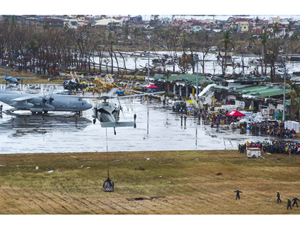

One week after Typhoon Haiyan hammered the central Philippines, a key road in one of the hardest-hit areas has been cleared and relief aid is starting to flow. But the damage is severe and extensive, and it is likely to be some time before major cleanup and rebuilding can begin.
While it was not immediately clear how involved engineering and construction firms would be in the relief and rebuilding efforts, two major multinational banks on Nov. 18 announced they would provide more than $1 billion in financial aid and dispatch "disaster experts."
The United Nations earlier had reached out to member countries for $300 million for immediate needs.
$1 Billion From Global Banks
In response to an emergency request from the Filipino government, the World Bank Group said it will provide a $500-million emergency loan and deploy a global team to support recovery and rebuilding efforts, said World Bank Group President Jim Yong Kim.
The bank also said it would provide other resources, including a cash transfer, to fund the building of temporary shelters and help with debris clean up, among other assistance to poor communities.
Members of a technical team from the bank are now arriving in the Philippines to help the government assess the damage and gather information for a comprehensive reconstruction plan, the bank says.
Given the scale of this disaster, the country will need a long-term reconstruction plan. "We can bring lessons learned from our work in reconstruction after disasters hit Aceh [Indonesia], Haiti, and other areas that might be helpful in the Philippines,” said Axel van Trotsenburg, World Bank vice president for East Asia Pacific. “Remote-sensing images are being obtained for use by the assessment [team]."
Van Trotsenburg also said the bank is providing technical assistance on disaster-resistant design options for structures that can withstand 250- to 280-kilometer-per-hour wind speeds and resist severe flooding.
The Asian Development Bank (ADB) said it will provide $23 million in grants for immediate needs, with an additional $500 million as an emergency loan for post-disaster rehabilitation and reconstruction.
"ADB is also exploring other ways of mobilizing resources, including the establishment of an ADB-administered multi-donor trust fund," the bank said, noting that it met on Nov. 18 with the World Bank and the Japan International Cooperation Agency to coordinate funding and recovery efforts.
Published reports suggest that, as of Nov. 18, at least 3,600 had died in the storm, citing an updated estimate received from the Philippines Dept. of Social Welfare and Development. Those new estimates further show the storm displaced more than 921,000 people and affected 11.8 million.
About 900 U.S. Marines, on Nov. 15, were preparing to head to the Philippines from Okinawa on Navy ships that also will carry backhoes, dump trucks and other heavy construction equipment as well as generators and water tanks. The unit, expected to arrive in the Philippines the week of Nov. 17, will help with clearing roads and distributing disaster-relief supplies. Another 100 Marines are expected to fly to the area.
Some design, construction and equipment firms are responding. U.K-based construction equipment-maker JCB and South Korea's Hyundai Heavy Industries both announced heavy-equipment donations to the relief efforts.
JCB, which has 18 factories globally, will send three 3CX backhoe loaders, and local Filipino distributor Camec will provide 120 generators. JCB Chairman Lord Bamford said in a statement that the equipment will be used for clearing roads for rescue operations.
Hyundai is sending a 21-ton excavator and backhoe, along with operators, as well as $200,000 in cash, said its president and CEO, Lee Jai-Seong, in a statement on its website.
California-based contractor ECC, which reported work in the Philippines last year in ENR’s list of the Top 400 Contractors, already had staff en route to the disaster area. On Nov. 15, CEO Manjiv Vohra told ENR the company is "in discussions with a few client organizations and should know more within a week or so.”
Australia-based Sinclair Knight Merz (SKM) has closed its business unit doing international aid projects in Southeast Asia since its acquisition last month by Jacobs Engineering Group, says a spokesman, but the firm is matching donations made by employees to Oxfam, which has been on the ground since the typhoon struck.
SKM also is sending hygiene packages and will support voluntary relief efforts by employees in the Philippines through Engineers Without Borders. SKM did the same in Indonesia after a tsunami struck the region in 2004, the spokesman says.
On its website, Engineers Without Borders is encouraging those who want to lend expertise and equipment to coordinate through the International Red Cross.
The American Institute of Architects has contacted other international design organizations to offer support to the United Architects of the Philippines, AIA President Mickey Jacob said on Nov. 12. Jacob also said AIA has contacted San Francisco-based Architecture for Humanity, which he says “is in the early stages of its response efforts.”





Post a comment to this article
Report Abusive Comment